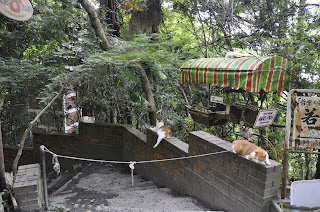Omiyage:
Gift given: Parasol
I
chose the fancy parasol/umbrella because it is one distinct images that come to
mind when I think of Japan after this trip. I was fascinated with the beautiful
umbrellas and parasols I saw everywhere and how pretty much everyone seemed to
have one. And there were definitely points on the trip when I didn’t have one
and really regretted it. I even started to notice how in most of the stores in
Japan there were places to store your umbrella while shopping and or bags so it
wouldn’t track water in.
In
the US parasols are seen far less frequently in my experience and it really
does remind me of Japan. I wanted to get an especially cute or fancy one
because I thought it would really represent the trip and be hard if not
impossible to find something like it in the US at the same price.
I
also chose this gift due to the fact that it is potentially useful, though
maybe less as a parasol and more as an umbrella. To find my gift I went back to
Harujuku, which is a well-known area even outside of Japan. I actually found it
in Bodyline, which is a store that
sells cosplay and Lolita clothing. This seemed perfect to me because it
combines mainstream ideas about Japan along with my personal experience in
Japan on this trip.
I
hope that Angela can use this if for nothing else as a memory of our trip to
Japan.
Gift Received: Bag of snacks
This
made a lot of sense to me because it reminded me of a Japanese convenience
store which I really miss now that I’m back in the US. It had 3 bottles of Sake
and an assortment of Japanese sweets. I have never really been one for sake,
but from our readings, general knowledge, and just my experience it’s a pretty
big Japanese thing. The snacks most of which I actually didn’t recognize are
another big thing that I associate with Japanese culture. There are so many
different and potentially strange snacks there. Things like melon soda and
their wide variety of “soda” flavored things.
Aside
from the three bottles of Sake there were two kinds of chocolate and fruit
cookies: strawberry and orange. Almonds covered in chocolate and mushrooms with
peanut butter caps. There was definitely an interesting assortment and variety,
which was nice. And I had never seen that flavor of the mushrooms before, it
was actually kinda funny because we couldn’t figure out what they were so we
asked Stanley and he couldn’t either. We decided it was peanut butter but
apparently its creamy Kinako. Which is a Japanese sweet soy powder that when
combined with chocolate tastes like peanut butter. Strange...
I
think this was a good omiyage because it really did remind me of the trip and
the time we spent in Japan. I got to try sake again...still don’t care for it. And
found some new snacks that I won’t be able to find in the US easily.











 Trekking up the winding hills from the bustling intersection
off of Manjuin-dori in northeast
Kyoto, beads of sweat slide down my nose and fall to the ground—the sun is
blistering and the air is thick, but finally a clear sky in Kyoto.
Trekking up the winding hills from the bustling intersection
off of Manjuin-dori in northeast
Kyoto, beads of sweat slide down my nose and fall to the ground—the sun is
blistering and the air is thick, but finally a clear sky in Kyoto.











